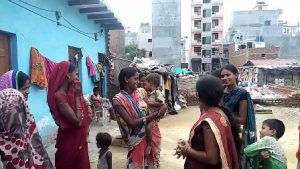COVID-19: Window for India to Review Slum and Urban Development Policies
It is indeed an opportune time for co-creating every step inherent in any urban plan through an extensive consultation process with the people.
The COVID-19 pandemic has created a disruption across the world with its origin and spread through cities. In India, dense slums and peri-urban areas have been the worst hit with the potential of spreading the infections further into the heartlands. The pandemic has exposed the vulnerabilities of 17 percent of Indian population living in urban slums in ways that probably few other incidents have in the recent past.
cities. In India, dense slums and peri-urban areas have been the worst hit with the potential of spreading the infections further into the heartlands. The pandemic has exposed the vulnerabilities of 17 percent of Indian population living in urban slums in ways that probably few other incidents have in the recent past.
It is a known fact that urban slums are characterised by inhuman living conditions, weak public health system, heavy dependence on largely unregulated informal economic activities and acute poverty. According to the WRI’s World Resources Report, one slum in Bengaluru houses 140,000 people per square kilometre, making the slum 12 times denser than the city average. Around 40 percent of the residents did not have access to piped water. Even the water available was inadequate with average availability of two hours per day and irregular with two to three days availability per week. Accessing water is an expensive and time-consuming process with the slum residents are generally left with the option of buying water at huge mark ups. This has even become costlier as work has dried up in the wake of India’s extended lockdown. In slums, where washing hands might require the residents to travel to a shared tap or drawing from a scarce household supply, contact and respiratory transmission are unavoidable.
The sufferings of the slum residents, being largely dependent on informal economic activities, are unmeasurable and often invisible. A recent survey in Bengaluru revealed that lives and livelihoods of the informal workers are interwoven in inextricable ways. Although the many low-income workers were afraid of contracting COVID-19, they were compelled to continue working for fear of losing income and jobs.
Work from home (WFH) has been coined and advertised as the new mantra to ensure adherence to the diktat of social distancing.
Dharavi, Asia’s largest slum, is estimated to have about 20,000 – 25,000 workshops and units across all economic activity where workers work and live in more or less the same space within an arm’s distance from one another. Such ‘live at workplace’ situation makes the possibility of the rapid spread of the current COVID-19 pandemic and heavy loss of life extraordinarily real.
In essence, the writing on the wall is clear that India should use this window to revision its discourse on urban plan and policies. The pandemic has renewed the debate about how slums should be managed. We suggest a five-pronged strategy to better prepare the slums for the current and future crises.
Firstly, as long-term strategy, city governments should ensure access and availability of urban basic services for all with a provision of free access to water and sanitation facilities for the poor people. However, for providing immediate relief, city governments should arrange for water tankers, mobile handwashing facilities, and other forms of rapid response in slums and vulnerable neighbourhoods.
Also Read : Housing and Smart Cities: Why a ‘Steel Transition’ is Required?
Secondly, for facilitating social distancing practices, it is necessary to emphasise on improving access to affordable housing. The Technical Group on Urban Housing Shortages (2012–17) estimated India’s urban housing shortages of 18.78 million in 2012, with three fourths of the shortages in the EWS (economically weaker section) category and another quarter of the shortage is among the LIG (low income group) category. The coronavirus outbreak should serve as a wake-up call for authorities and policymakers to scale up the affordable housing.
Thirdly, fiscal and functional empowerment of city governments will allow them to handle any emergency speedily and effectively. As short-term measures, central governments should provide additional fund and also allow them to utilise the funds available with them under different central government schemes, so that they can immediately distribute cash assistance to those who need it most.
Fourthly, prevailing top-down model of urban planning processes in India requires a complete overhaul. Any city plan should embrace the needs, aspirations and wishes of the local people to make their city more liveable.
It is indeed an opportune time for co-creating every step (ideas, strategies, implementing mechanism and financial solutions) inherent in any urban plan through an extensive consultation process with the people.
City governments should be directed now to work more closely with community leaders and NGOs working in the slums to better understand ground-level scenarios as well as to communicate key health messages.
Also Read : COVID-19 Crisis in Cities: Re-thinking City Governance Must
Fifthly, cities in India suffer from inadequate data and information which has not only undermined their own ability, but also that of the analysts and policy makers to comprehend the ground-level situation and to develop and implement effective urban policies. For example, data will be the key to the Ministry of Health, Government of India’s declaration of a ‘Containment Zone’ with a “large outbreak” of positive COVID-19 cases and its subsequent decision to seal the “defined geographic area” for containment of the pandemic. Therefore, it is imperative to build up a repository of more granular, regularly updated data to empower the city governments with informed evidence-based policy making.
Dr Soumyadip Chattopadhyay is Associate Professor of Economics at the Visva Bharati University, Shanti Niketan, and Coordinator, Centre for Habitat, Urban and Regional Studies (CHURS), and Senior Fellow at Impact and Policy Research Institute (IMPRI), New Delhi. Dr Arjun Kumar is Director, Impact and Policy Research Institute (IMPRI), New Delhi and China-India Visiting Scholar (CIVS) Fellow, Ashoka University.
